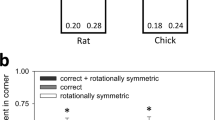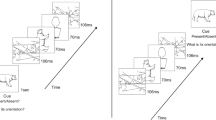Abstract
A substantial amount of empirical and theoretical debate remains concerning the extent to which an ability to orient with respect to the environment is determined by global (i.e., principal axis of space), local (i.e., wall lengths, angles), and/or view-based (i.e., stored representation) accounts. We developed an orientation task that allowed the manipulation of the reliability of the principal axis of space (i.e., searching at the egocentric left- and/or right-hand side of the principal axis) between groups while maintaining goal distance from the principal axis, local cues specifying the goal location (i.e., short wall left, short wall right, and obtuse angle), and visual aspects of the goal location consistent across groups. Control and test trials revealed that participants trained with a reliable principal axis of space utilized both global and local geometric cues, whereas those trained with an unreliable principal axis of space utilized only local geometric cues. Results suggest that both global and local geometric cues are utilized for reorientation and that the reliability of the principal axis of an enclosure differentially influences the use of geometric cues. Such results have implications for purely global-based, purely local-based, and purely view-based matching theoretical accounts of geometry learning and provide evidence for a unified orientation process.


Similar content being viewed by others
References
Alexander T, Wilson SP, Wilson PN (2009) Blocking of goal-location learning based on shape. J Exp Psychol Learn Mem Cogn 35:694–708
Brown AA, Spetch ML, Hurd PL (2007) Growing in circles: rearing environment alters spatial navigation in fish. Psychol Sci 18:569–573
Cheng K (1986) A purely geometric module in the rat’s spatial representation. Cognition 23:149–178
Cheng K (2005) Reflections on geometry and navigation. Connect Sci 17:5–21
Cheng K (2008) Whither geometry? Troubles of the geometric module. Trends Cogn Sci 12:355–361
Cheng K, Gallistel CR (2005) Shape parameters explain data from spatial transformations: Comment on Pearce et al. (2004) and Tommasi and Polli (2004). J Exp Psychol Anim Behav Process 31:254–259
Cheng K, Newcombe NS (2005) Is there a geometric module for spatial orientation? Squaring theory and evidence. Psychon Bull Rev 12:1–23
Cheng K, Newcombe NS (2006) Geometry, features, and orientation in vertebrate animals: a pictorial review. In: Brown MF, Cook RG (eds) Animal spatial cognition: comparative, neural, and computational approaches. [On-line]. Available:http://www.pigeon.psy.tufts.edu/asc/cheng/
Cheng K, Shettleworth SJ, Huttenlocher J, Rieser JJ (2007) Bayesian integration of spatial information. Psychol Bull 133:625–637
Collett TS, Zeil J (1998) Places and landmarks: An arthropod perspective. In: Healy S (ed) Spatial representation in animals. Oxford University Press, Oxford, England, pp 18–53
Dawson MRW, Kelly DM, Spetch ML, Dupuis B (2010) Using perceptrons to explore the reorientation task. Cognition 14:207–226
Doeller CF, Burgess N (2008) Distinct error-correcting and incidental learning location relative to landmarks and boundaries. Proc Natl Acad Sci 105:5909–5914
Doeller CF, King JA, Burgess N (2008) Parallel striatal and hippocampal systems for landmarks and boundaries in spatial memory. Proc Natl Acad Sci 105:5915–5920
Gallistel CR (1990) The organization of learning. MIT Press, Cambridge, MA
Gouteux S, Thinus-Blanc C, Vauclair J (2001) Rhesus monkeys use geometric and non-geometric information during a reorientation task. J Exp Psychol Gen 130:505–519
Graham M, Good M, McGregor A, Pearce JM (2006) Spatial learning based on the shape of the environment is influenced by properties of the objects forming the shape. J Exp Psychol Anim Behav Process 32:44–59
Gray ER, Bloomfield LL, Ferrey A, Spetch ML, Sturdy CB (2005) Spatial encoding in mountain chickadees: Features overshadow geometry. Biol Lett 1:314–317
Healy S (1998) Spatial representation in animals. Oxford, New York
Hermer L, Spelke E (1994) A geometric process for spatial representation in young children. Nature 370:57–59
Hermer-Vazquez L, Spelke E, Katsnelson A (1999) Source of flexibility in human cognition: dual task studies of space and language. Cogn Psychol 39:3–36
Kelly DM (2010) Features enhance encoding of geometry. Animal Cogn 13:453–462
Kelly DM, Bischof WF (2008) Orienting in virtual environments: how are surface features and environmental geometry weighted in an orientation task? Cognition 109:89–104
Kelly DM, Spetch ML (2001) Pigeons encode relative geometry. J Exp Psychol Anim Behav Process 27:417–422
Kelly DM, Chiandetti C, Vallortigara G (2010) Re-orienting in space: do animals use global or local geometry strategies? Biol Lett. doi:10.1098.rsbl.2010.1024
Learmonth AE, Newcombe NS, Huttenlocher J (2001) Toddlers’ use of metric information and landmarks to reorient. J Exp Child Psychol 80:225–244
Learmonth AE, Nadel L, Newcombe NS (2002) Children’s use of landmarks: Implications for modularity theory. Psychol Sci 13:337–341
Miller NY (2009) Modeling the effects of enclosure size on geometry learning. Behav Process 80:306–313
Miller NY, Shettleworth SJ (2007) Learning about environmental geometry: An associative model. J Exp Psychol Anim Behav Process 33:191–212
Nardini M, Jones P, Bedford R, Braddick O (2008) Development of cue integration in human navigation. Curr Biol 18:689–693
Nardini M, Thomas RL, Knowland VCP, Braddick O, Atkinson J (2009) A viewpoint-independent process for spatial reorientation. Cognition 112:241–248
Newcombe NS, Ratliff KR (2007) Explaining the development of spatial reorientation: Modularity-plus-language versus the emergence of adaptive combination. In: Plumert J, Spencer J (eds) The emerging spatial mind. Oxford, New York, pp 53–76
Pecchia T, Vallortigara G (2010) View-based strategy for reorientation by geometry. J Exp Biol 213:2987–2996
Ponticorvo M, Miglino O (2010) Encoding geometric and non-geometric information: a study with evolved agents. Anim Cogn 13:157–174
Ratliff KR, Newcombe NS (2008) Reorienting when cues conflict: Evidence for an adaptive combination view. Psychol Sci 19:1301–1307
Sovrano VA, Vallortigara G (2006) Dissecting the geometric module: A sense linkage for metric and landmark information in animals’ spatial reorientation. Psychol Sci 17:616–621
Sovrano VA, Bisazza A, Vallortigara G (2005) Animals’ use of landmarks and metric information to reorient: Effects of the size of the experimental space. Cognition 97:121–133
Sovrano VA, Bisazza A, Vallortigara G (2007) How fish do geometry in large and in small spaces. Anim Cogn 10:47–54
Spetch ML, Kelly DM (2006) Comparative spatial cognition: Processes in landmark- and surface-based place finding. In: Wasserman EA, Zentall TR (eds) Comparative cognition: Experimental explorations of animal intelligence. Oxford University Press, Oxford, England, pp 210–228
Sturz BR, Bodily KD (2010) Encoding of variability of landmark-based spatial information. Psychol Res 74:560–567
Sturz BR, Diemer SM (2010) Reorienting when cues conflict: a role for information content in spatial learning? Behav Process 83:90–98
Sturz BR, Kelly DM (2009) Encoding of relative enclosure size in a dynamic three-dimensional virtual environment by humans. Behav Process 82:223–227
Sturz BR, Brown MF, Kelly DM (2009) Facilitation of learning spatial relations among locations by visual cues: Implications for theoretical accounts of spatial learning. Psychon Bull Rev 16:306–312
Sturz BR, Gurley T, Bodily KD (2011) Orientation in trapezoid-shaped enclosures: implications for theoretical accounts of geometry learning. J Exp Psychol Animal Behav Process. doi:10.1037/a0021215
Stürzl W, Cheung A, Cheng K, Zeil J (2008) The information content of panoramic images I: the rotational errors and the similarity of views in rectangular experimental arenas. J Exp Psychol Anim Behav Process 34:1–14
Sutton JE, Joanisse MF, Newcombe NS (2010) Spinning in the scanner: neural correlates of virtual reorientation. J Exp Psychol Learn Mem Cogn 36:1097–1107
Twyman AD, Newcombe NS (2010) Five reasons to doubt the existence of a geometric module. Cogn Sci 34:1315–1356
Vallortigara G (2009) Animals as natural geometers. In: Tommasi L, Peterson MA, Nadel L (eds) Cognitive biology: Evolutionary and developmental perspectives on mind, brain, and behavior. MIT Press, Cambridge, MA, pp 83–104
Vallortigara G, Feruglio M, Sovrano VA (2005) Reorientation by geometric and landmark information in environments of different sizes. Dev Sci 8:393–401
Wystrach A, Beugnon G (2009) Ants learn geometry and features. Curr Biol 19:61–66
Acknowledgments
This research was conducted following the relevant ethical guidelines for human research and supported by a National Science Foundation Science and Technology Expansion Program (NSF-STEP DUE-0856593) Grant to the College of Science and Technology at AASU and an AASU Summer Research Grant to BRS. We thank Kate Gaskin, April Graves, and Taylor Gurley for assistance with data collection, scoring, and editorial comments. We are grateful to three anonymous reviewers for comments on an earlier version of this manuscript.
Author information
Authors and Affiliations
Corresponding author
Additional information
Please note that first and third authors contributed equally to this project.
Rights and permissions
About this article
Cite this article
Bodily, K.D., Eastman, C.K. & Sturz, B.R. Neither by global nor local cues alone: evidence for a unified orientation process. Anim Cogn 14, 665–674 (2011). https://doi.org/10.1007/s10071-011-0401-x
Received:
Revised:
Accepted:
Published:
Issue Date:
DOI: https://doi.org/10.1007/s10071-011-0401-x




